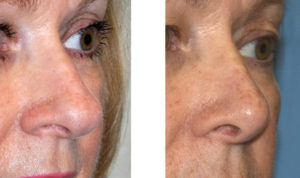Rhinoplasty surgery is capable of making a number of different changes to the shape of the nose. One of these potential changes is in the length of the nose. A nose’s length is measured from a point between the eyebrows at the top of the nose (an anthropometric point known as rhinion) down the bridge to the end of the tip of the nose. In theory, the proper length of the nose is supposed to be the same length as your ear. And there are a variety of mathematical ratios that also calculate what one’s nose length should be. However, you either feel your nose is too long or you don’t…as that is more pertinent than any other analysis.

A long nose is usually caused by an overgrown or long underlying septum. Like the central pole in a tent, the septum is the driving force behind the support and position of the lower alar cartilages which make up the nasal tip known as the dome. If the septum is long, it will drive the tip out and down increasing the length of the nose. Externally, this is apparent by more of a downturned tip or an acute nasolabial angle. (angle between the columella of the nose and the upper lip)
A long nose can be shortened primarily by resecting part of the end of the septum where it sits behind the columella. (strip of skin between the nostrils) By shortening it and changing the angle of its end, the tip cartilages of the nasal tip can be moved back. As the nasal tip moves back and up, it opens up the nasolabial angle. This creates both a true and an illusionary shortening of the nose.
Because accuracy and proper repositioning of the septal-alar cartilage relationship is needed when shortening a nose, an open rhinoplasty approach is best used. When the long nose is shortened, the hump on a nose (if it exists) will become less apparent as the dorsal line is changed. For some, this may mean that hump modification is not needed. For others, less aggressive hump reduction techniques may be used.
Shortening a nose and changing the tip angle can have a significant change in one’s facial appearance. It can change how other facial structures look as well, particularly that of the chin.
Dr. Barry Eppley
Indianapolis, Indiana


